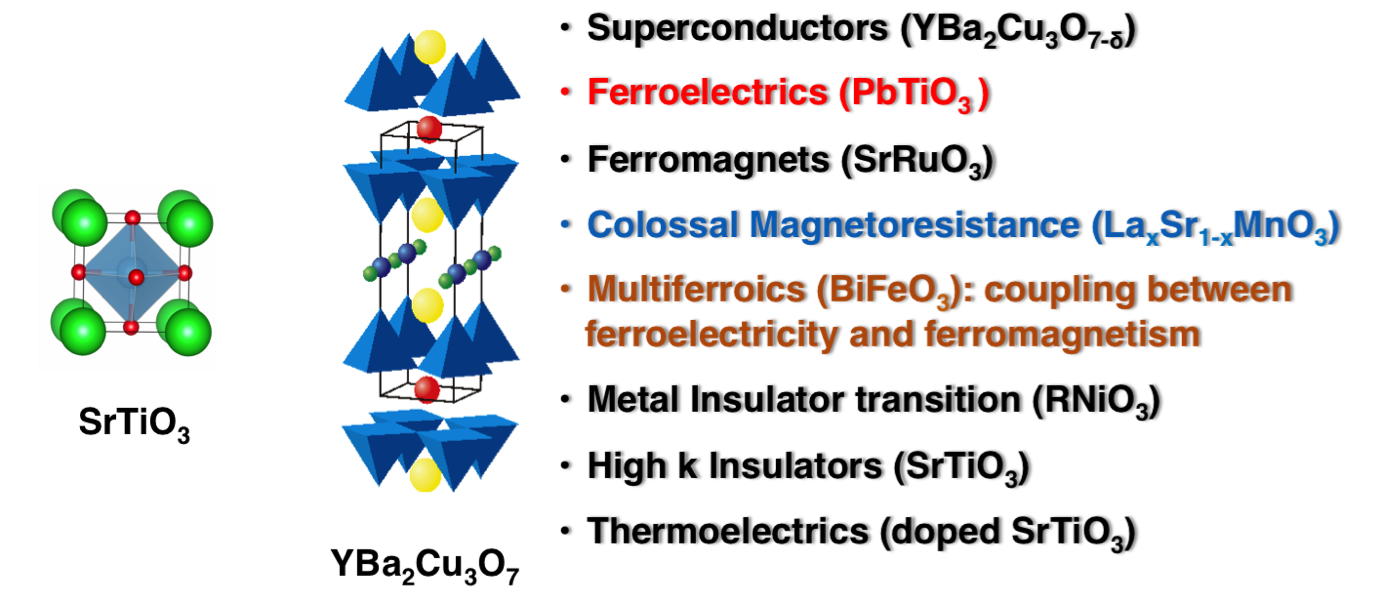Research Interests:
Perovskite Oxides: lots of possibilities
Perovskite oxides and structurally related materials have attracted intense research interests during past decades in both materials science research and condensed matter physics. They comprise of a broad spectrum of interesting functionalities, such as high temperature superconducting, colossal magnetoresistance, (anti-) ferromagnetic, (anti-) ferroelectric, piezoelectric and more recently multiferroic properties, just to name a few. The wide range of material properties and rich physics involved have led to extensive studies to understand the fundamental nature of existing systems, so as to better control/design novel materials for applications.
Novel multiferroic
Multiferroics are materials exhibiting more than one primary ferroic order parameter, such as (anti-) ferromagnetism, (anti-) ferroelectricity, ferroelasticity and ferrotoriodicity.
Due to the strong coupling between the charge and spin degrees of freedom, multiferroics have great potentials for applications in novel memory devices, magnetic sensors, actuators and switches. Moreover, these materials also provide a great platform to investigate the coupling and correlation between different degrees of freedom and extend novel pathway to design material systems with new functionalities. However due to the mutual exclusion of ferroelectricity and magnetism, there are only a few groups of multiferroics so far and magnetoelectric couplings are rather small. Design novel multiferroics with promising magnetoelectric coupling becomes one of the focal points of the current condensed matter physics and material science research interest. Epitaxial strain, mismatch of the lattice constants between films and substrates has been well developed and demonstrated a wide variety of functionalities. For instance, epitaxial strain can induce ferroelectricity in non-ferroelectric materials, enhance (or suppress) the transition temperature of ferromagnetic manganites or increase the transition temperature of high temperature superconductivity. Here, using the powerful approach of epitaxial strain, we will design and investigate a new class of multiferroic materials with desirable material properties and coupling mechanism. We are also interested in exploring novel multiferroic device architecture and functionalities.
Emergent Phenomena at complex oxide interfaces
Controlling the interface of materials with atomic precision to obtain novel properties and functionalities has been at the forefront of both modern condensed matter physics and materials science, since they can give rise to a wide range of remarkable novel properties. From the observation of a high mobility two-dimensional electron gas at the interface between two insulators to the observation of novel magnetism across interfaces, such artificially engineered interfaces are emerging as a new horizon in materials science these days. Using the state of art LMBE system, our group can design and fabricate high quality oxide heterointerfaces with atomic scale precision control. Such interface provides a solid platform to trigger the studies of novel phenomena and functionalities. A rich spectrum of physical properties are expected to be emerging from these designed interfaces.
Quantum confinement in strongly correlated electron systems
Complex oxide materials exhibit a rich spectrum of functionalities. When dimensionality confinement is applied into such system, the competitions between different degrees of freedom and their subtle interactions lead to exotic properties. Conventionally, this can be achieved through ultra-thin film architecture or nano-structures with nano-fabrications. Here, the designed periodic (ferroelectric, ferromagnetic, etc.) domain structures provide a novel platform for such studies. We are interested in probing magnetism and electronic transport of such nano-structures and further understanding their underlying physical mechanisms.




